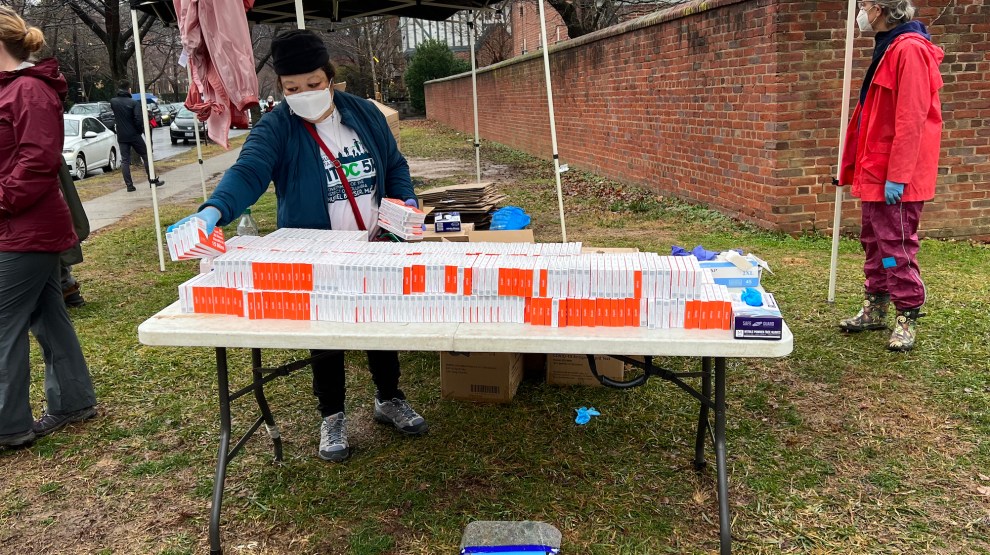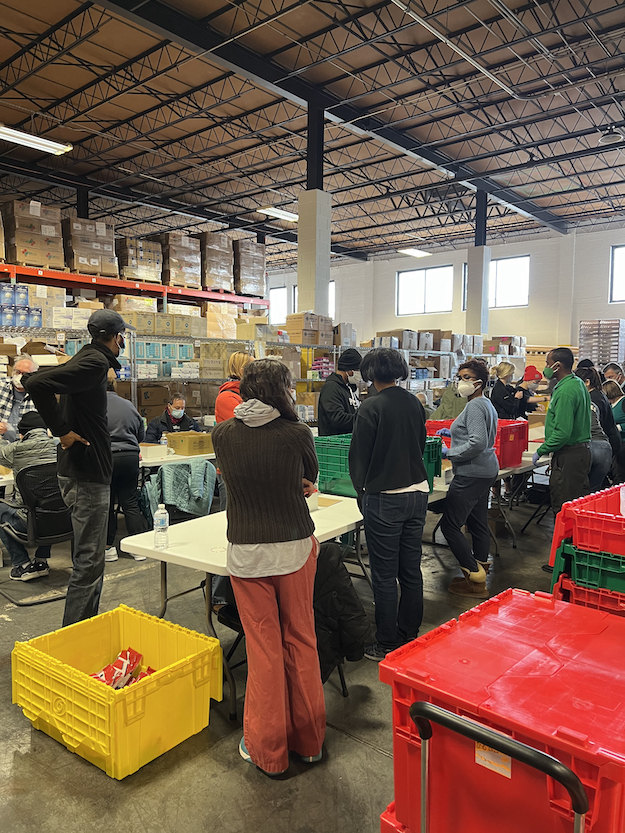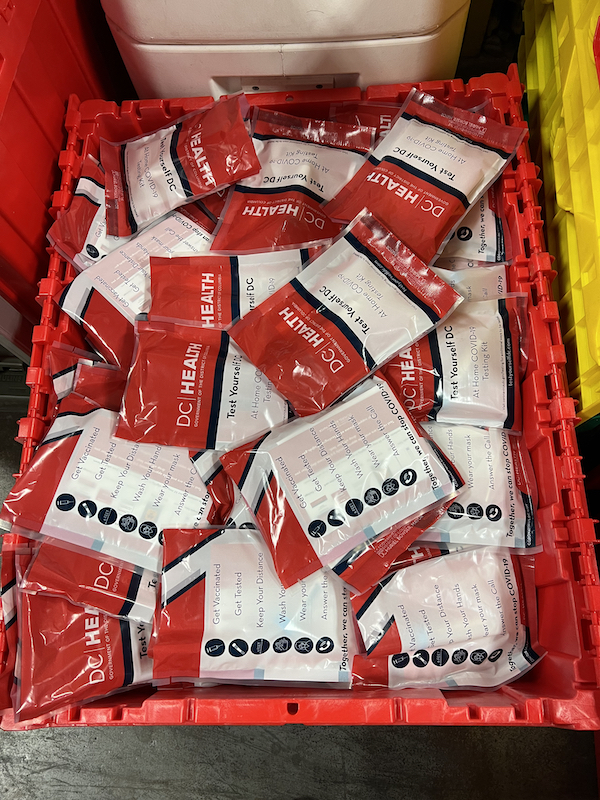
Volunteers give out free rapid Covid tests at a DC fire station on New Year's Day.Stephanie Mencimer/Mother Jones
Four days before Christmas, my son and I drove to the DC Costco and parked, but instead of going shopping, we walked down the hill and went into a nondescript DC government warehouse. There, we walked around thousands of boxes of Covid testing supplies to join a few dozen other vaccinated and masked DC residents who’d responded to the city’s call for volunteers to assemble Covid PCR test kits that people could use at home. We spent a few hours on the assembly line, folding up Labcorp baggies and instruction leaflets for the volunteers at the next table to stuff into packages and vacuum seal.
Once they were quality checked, the kits went right out the door to city libraries, where residents could pick up two a day for free. After they swabbed their noses, residents could drop the kit into a library pickup box outside. After 8 pm, the city transported the tests to a lab for processing and, in a few days, results would be emailed. Over the course of the next three weeks or so, 1,800 volunteers from all over the city assembled approximately 85,000 test kits for distribution, according to the DC Department of Health.

Volunteers assemble at-home Covid PCR tests at a DC government warehouse in December.
It was a remarkable operation, and an unusual moment of civic engagement. I couldn’t think of another time when I’d been called up by the government to do much of anything besides renew my drivers’ license. Packing tests side by socially-distanced side with my fellow Washingtonians to fight a common enemy felt like being part of a war effort. The virus was surging, and all sorts of people had answered the call. Even more surprising, from my perspective, was just how efficient the whole thing was, and in DC of all places.
Everywhere else across the country, it seemed, both the federal and local governments were floundering as the Omicron variant surged, and along with it, the demand for more and easier testing. For almost two years, experts had been calling on the nation to improve its testing infrastructure as the way back to normal life.
“I actually have been saying that for months and months and months, we should be literally flooding the system with easily accessible, cheap, not needing a prescription, point of care, highly sensitive and highly specific” tests, White House chief medical advisor Dr. Anthony Fauci said at a congressional hearing in March 2021.
But in December, it was clear those calls had largely gone unheeded. “Hunting A Rapid Covid Test for the Holidays? Good Luck With That,” went an NPR story on December 13. Just days before our volunteer shift, news reports from New York City were pouring in about three-hour long waits to get a Covid tests as cases had surged 277 percent in the previous two weeks. The Biden administration seemed to be hoping for a free market solution, pleading with insurance companies to cover at-home rapid antigen tests, even though the tests were both expensive and exceedingly scarce. The administrative headaches of involving the insurance companies in over-the-counter testing were so obvious that they later became TikTok fodder for The Daily Show. (“Call the insurance company? I’d rather get Covid!”)
Biden administration explains how free Covid tests will be distributed pic.twitter.com/iMYo4fhwvm
— The Daily Show (@TheDailyShow) January 13, 2022
State governments were experiencing the déjà vu of 2020, when they were competing against each other for masks and other protective equipment and driving up the costs. In October, Reuters reported that South Carolina was paying as much as $130 each for Covid tests that can cost about $2 to make.
There was no reason to believe that things would be any better in DC, which once was synonymous with dysfunctional municipal government. Home of the late “Mayor for Life” Marion Barry, a nearly bankrupt DC was even taken over by a congressionally appointed control board in 1995 shortly after Barry was reelected to his fourth term as mayor despite having been released from prison only two years earlier after serving a six-month sentence for cocaine possession. So I was primed to expect the worst here, especially by mid-December, when the city’s Covid cases skyrocketed 1,300 percent over two weeks, making it a leading national hotspot. And yet, as I discovered in the DC health department warehouse, the District is now one of the easiest places in the country to get a Covid test. Over the past seven days, DC has reported more tests per 100,000 residents than any other state—14,063 tests, which is nearly five times the national average. Only Vermont even comes close to DC’s testing numbers.
I was curious to know why DC’s Covid testing infrastructure is so good when other places seem to be struggling so much. Is it because of our unique relationship with the federal government? I put those questions to Patrick Ashley, the senior deputy director of the DC Health Emergency Preparedness and Response Administration who is overseeing much of the Covid response. He says that while the federal government has provided funding, it hasn’t been involved locally otherwise. He thinks what’s distinguished the city’s work is that it did not leave the public health response up to the private sector to figure out. While private sector partners like Labcorp and Microsoft have been critical, he said, it has been the city government that made it all come together.
“One thing DC does really well,” he said, is involve every layer of the government, not just the health department. For instance, officials tried to make sure that every city resident had a testing site within a 20-minute walk, a goal that led to the department using fire stations as test sites. “When we first talked about doing testing at firehouses people thought we were crazy, but it turned out hyperlocal was great,” Ashley says. “People trust the fire department.”
People also like libraries, where starting in March, 2021, the city started distributing take-home PCR tests—like the ones we assembled—an innovation the city started working on back in October 2020 when vaccines were still a few months away. (The January 6 insurrection at the US Capitol delayed the initial rollout.) Ashely says they came up with the idea of the having a library drop box for the at-home tests from the DC Board of Elections, which uses virtually the same ones for drop-off ballots.

The elections board advised on the procurement of the drop boxes, which the Department of Public Works installed, while also providing traffic control at the in-person testing sites. And through a partnership with Microsoft and an assist from the office of the DC’s Chief Technology officer, the city was able to expand on its existing vaccine platform to set up the website that manages all the test results.
When I walked into the DC health warehouse last month, I marveled that the city could recruit volunteers on such short notice, and that it had the wherewithal to organize them for meaningful work. But the city’s volunteer platform, Serve DC, had been in place for several years as sort of government-sponsored mutual aid effort, organizing emergency preparedness trainings and deploying teams to shovel the walks of the District’s senior citizens after a snowstorm. This infrastructure came in handy when the health department needed Covid testing volunteers.
“It was the entirety of the government that responded to the pandemic,” explained Ashley, who talks regularly to his counterparts in other cities. “In other jurisdictions, the health departments were left to do things without a lot of resources.”
In early December, White House press secretary Jen Psaki publicly dismissed the idea that the government should give everyone free rapid tests. But since October, the DC municipal government had been planning to do just that, and in early December, it went big, Ashley says, and ordered 6 million tests. That’s why DC residents already have easy access to so many free tests that the Biden administration is only now trying to mail to the rest of the country. The city has used those tests to flood the zone—and perhaps most importantly, to try to keep the public schools open.
After the winter holiday, the city distributed take-home rapid antigen tests to about 48,000 public school students and staff and required them all to report the results online on Jan. 4 before they could return to school. (More than 40,000 charter school students were also supposed test, in a more decentralized effort.) If students didn’t test at home, they could do so at school, where tests were available it at the door before they could come in. It was an all-hands on deck effort of the sort experts had been calling for since 2020.
Cynically, I suspected that the odds were high that the website would crash when all 48,000 results were uploaded into the system—sort of what you’d expect when the government tries to do anything, like sell Obamacare insurance plans. There were a few glitches, but for the most part, the testing initiative worked surprisingly well. About 6 percent of kids and 7 percent of the staff tested positive—numbers low enough that all but one school was able to open in person (at least until snow arrived the next day, and the return to school was put off for a long weekend).
Last week the city announced it would continue to distribute rapid tests to pre-K and kindergarten students, who are too young to be vaccinated, and to all students before a long holiday like spring break, with a negative test required to return to school. And Mayor Muriel Bowser recently announced that the city was preparing a “test to stay” program that would allow kids who weren’t sick but were exposed to someone who tested positive to stay in school and avoid disruptive quarantines. The massive testing effort seems to have reassured many nervous parents enough to send their kids back into the building.
On New Year’s Day, my son and I reported to a local fire station along with about 25 others to help distribute some of those free rapid antigen tests to the public. I was surprised that so many people came out to devote a few hours of their time on the holiday, in the rain, no less. Two years into the pandemic, it was as if they had just been waiting for someone to ask them to do something to help. Of course, many of the permanent residents of DC tend to be do-gooders. District residents didn’t win the right to elect their own mayor and city council until 1973, and most of the city’s earliest home rule leaders were veteran civil rights and anti-poverty organizers. Even today, DC is home to lots of people who work in nonprofits, former Peace Corps volunteers, good government watchdog groups, and federal government employees who believe that government can (and should) be a force for good rather than an inherent evil—the way some people in this country seem to view it.
At the fire station, most of us were in charge of line management, issuing instructions to the dozens of anxious people who had lined up around the block an hour before the distribution site opened. But 20 minutes after firefighters started handing out tests, the line had vanished—but not because the supply was exhausted. There were still more than enough tests available, and all afternoon we saw an orderly yet steady stream of people stop by for kits. For weeks, the CVS by my house had been putting up signs indicating that it was out of rapid tests and could not predict when more would come in. But on New Year’s Day, if you wanted a rapid test in DC, you could get free ones from the fire station—unless, that is, you weren’t a DC resident.
P St CVS. Story of our time. Also: no wrapping paper:( pic.twitter.com/HyZTpvBnyr
— Stephanie Mencimer (@smencimer) December 24, 2021
During our shift, we turned away a number of unhappy hopefuls from across the state line who tried to take advantage of the DC taxpayer-funded supplies. One man asked me mournfully, “Is Maryland doing anything like this?” It was not. At that point, neighboring Montgomery County, Md., just one mile away, was giving out free rapid tests only to a very narrow range of people, like those experiencing homelessness, and only through safety net clinics and other primary care facilities. “People don’t understand how lucky we are in DC,” Ashley said.
This article has been updated.
















